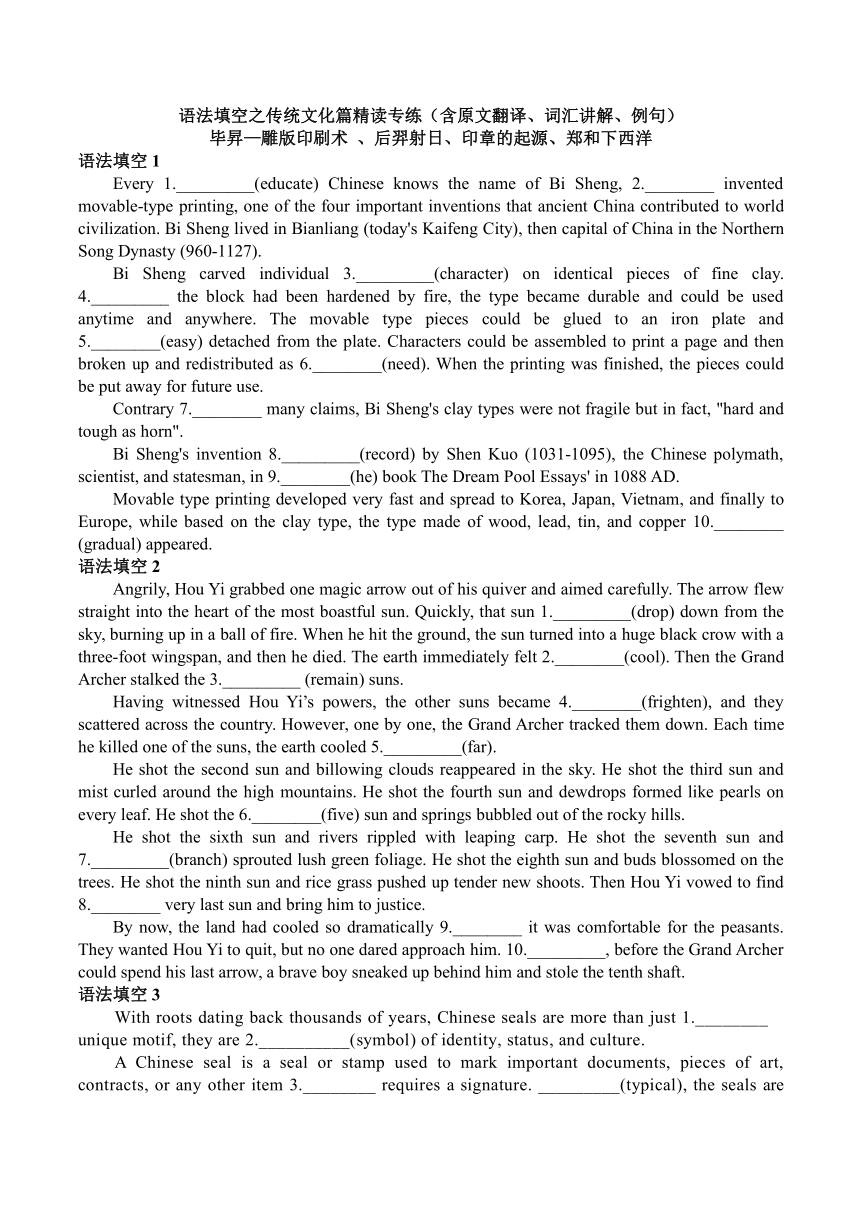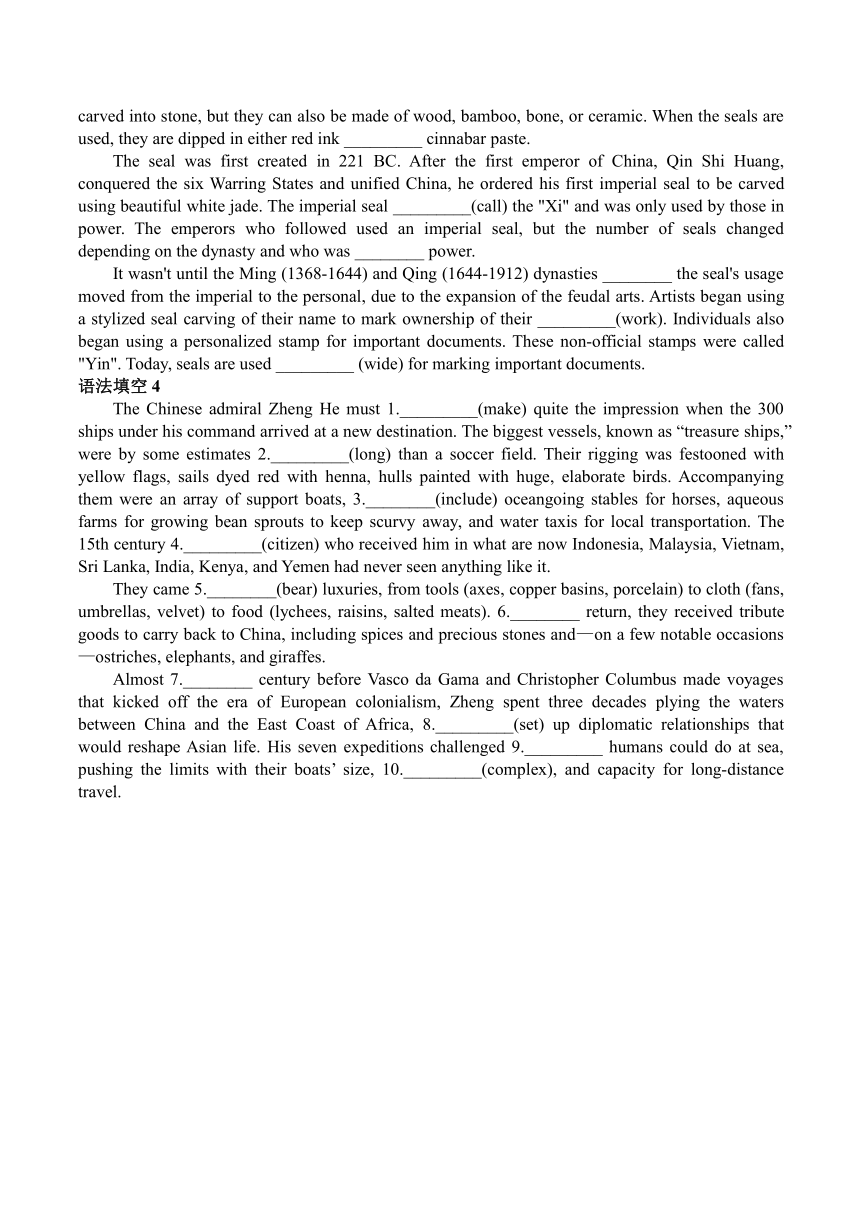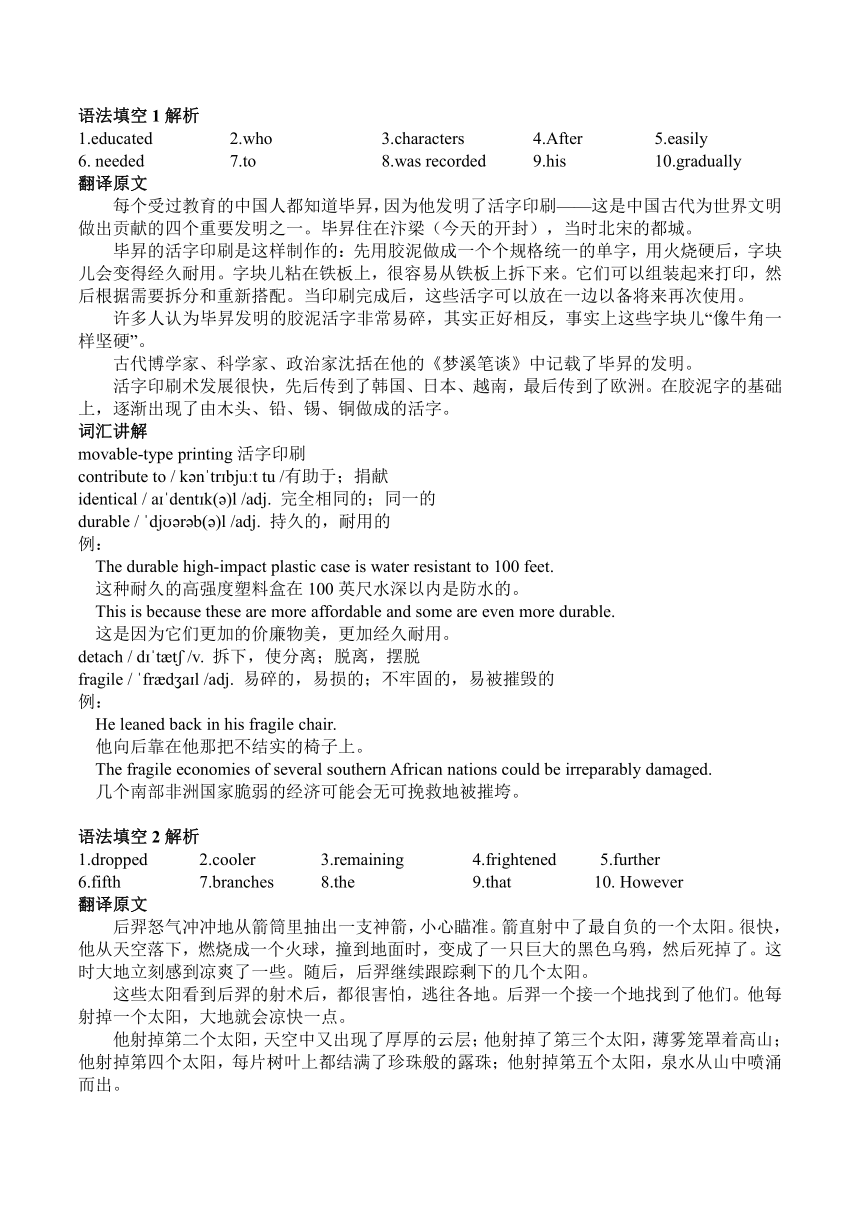2025语法填空之传统文化篇精读专练(含答案、原文翻译、词汇讲解、例句
文档属性
| 名称 | 2025语法填空之传统文化篇精读专练(含答案、原文翻译、词汇讲解、例句 |  | |
| 格式 | docx | ||
| 文件大小 | 27.0KB | ||
| 资源类型 | 教案 | ||
| 版本资源 | 人教版(2019) | ||
| 科目 | 英语 | ||
| 更新时间 | 2025-03-25 09:33:57 | ||
图片预览



文档简介
语法填空之传统文化篇精读专练(含原文翻译、词汇讲解、例句)
毕昇—雕版印刷术 、后羿射日、印章的起源、郑和下西洋
语法填空1
Every 1._________(educate) Chinese knows the name of Bi Sheng, 2.________ invented movable-type printing, one of the four important inventions that ancient China contributed to world civilization. Bi Sheng lived in Bianliang (today's Kaifeng City), then capital of China in the Northern Song Dynasty (960-1127).
Bi Sheng carved individual 3._________(character) on identical pieces of fine clay. 4._________ the block had been hardened by fire, the type became durable and could be used anytime and anywhere. The movable type pieces could be glued to an iron plate and 5.________(easy) detached from the plate. Characters could be assembled to print a page and then broken up and redistributed as 6.________(need). When the printing was finished, the pieces could be put away for future use.
Contrary 7.________ many claims, Bi Sheng's clay types were not fragile but in fact, "hard and tough as horn".
Bi Sheng's invention 8._________(record) by Shen Kuo (1031-1095), the Chinese polymath, scientist, and statesman, in 9.________(he) book The Dream Pool Essays' in 1088 AD.
Movable type printing developed very fast and spread to Korea, Japan, Vietnam, and finally to Europe, while based on the clay type, the type made of wood, lead, tin, and copper 10.________ (gradual) appeared.
语法填空2
Angrily, Hou Yi grabbed one magic arrow out of his quiver and aimed carefully. The arrow flew straight into the heart of the most boastful sun. Quickly, that sun 1._________(drop) down from the sky, burning up in a ball of fire. When he hit the ground, the sun turned into a huge black crow with a three-foot wingspan, and then he died. The earth immediately felt 2.________(cool). Then the Grand Archer stalked the 3._________ (remain) suns.
Having witnessed Hou Yi’s powers, the other suns became 4.________(frighten), and they scattered across the country. However, one by one, the Grand Archer tracked them down. Each time he killed one of the suns, the earth cooled 5._________(far).
He shot the second sun and billowing clouds reappeared in the sky. He shot the third sun and mist curled around the high mountains. He shot the fourth sun and dewdrops formed like pearls on every leaf. He shot the 6.________(five) sun and springs bubbled out of the rocky hills.
He shot the sixth sun and rivers rippled with leaping carp. He shot the seventh sun and 7._________(branch) sprouted lush green foliage. He shot the eighth sun and buds blossomed on the trees. He shot the ninth sun and rice grass pushed up tender new shoots. Then Hou Yi vowed to find 8.________ very last sun and bring him to justice.
By now, the land had cooled so dramatically 9.________ it was comfortable for the peasants. They wanted Hou Yi to quit, but no one dared approach him. 10._________, before the Grand Archer could spend his last arrow, a brave boy sneaked up behind him and stole the tenth shaft.
语法填空3
With roots dating back thousands of years, Chinese seals are more than just 1.________ unique motif, they are 2.__________(symbol) of identity, status, and culture.
A Chinese seal is a seal or stamp used to mark important documents, pieces of art, contracts, or any other item 3.________ requires a signature. _________(typical), the seals are carved into stone, but they can also be made of wood, bamboo, bone, or ceramic. When the seals are used, they are dipped in either red ink _________ cinnabar paste.
The seal was first created in 221 BC. After the first emperor of China, Qin Shi Huang, conquered the six Warring States and unified China, he ordered his first imperial seal to be carved using beautiful white jade. The imperial seal _________(call) the "Xi" and was only used by those in power. The emperors who followed used an imperial seal, but the number of seals changed depending on the dynasty and who was ________ power.
It wasn't until the Ming (1368-1644) and Qing (1644-1912) dynasties ________ the seal's usage moved from the imperial to the personal, due to the expansion of the feudal arts. Artists began using a stylized seal carving of their name to mark ownership of their _________(work). Individuals also began using a personalized stamp for important documents. These non-official stamps were called "Yin". Today, seals are used _________ (wide) for marking important documents.
语法填空4
The Chinese admiral Zheng He must 1._________(make) quite the impression when the 300 ships under his command arrived at a new destination. The biggest vessels, known as “treasure ships,” were by some estimates 2._________(long) than a soccer field. Their rigging was festooned with yellow flags, sails dyed red with henna, hulls painted with huge, elaborate birds. Accompanying them were an array of support boats, 3.________(include) oceangoing stables for horses, aqueous farms for growing bean sprouts to keep scurvy away, and water taxis for local transportation. The 15th century 4._________(citizen) who received him in what are now Indonesia, Malaysia, Vietnam, Sri Lanka, India, Kenya, and Yemen had never seen anything like it.
They came 5.________(bear) luxuries, from tools (axes, copper basins, porcelain) to cloth (fans, umbrellas, velvet) to food (lychees, raisins, salted meats). 6.________ return, they received tribute goods to carry back to China, including spices and precious stones and—on a few notable occasions—ostriches, elephants, and giraffes.
Almost 7.________ century before Vasco da Gama and Christopher Columbus made voyages that kicked off the era of European colonialism, Zheng spent three decades plying the waters between China and the East Coast of Africa, 8._________(set) up diplomatic relationships that would reshape Asian life. His seven expeditions challenged 9._________ humans could do at sea, pushing the limits with their boats’ size, 10._________(complex), and capacity for long-distance travel.
语法填空1解析
1.educated 2.who 3.characters 4.After 5.easily
6. needed 7.to 8.was recorded 9.his 10.gradually
翻译原文
每个受过教育的中国人都知道毕昇,因为他发明了活字印刷——这是中国古代为世界文明做出贡献的四个重要发明之一。毕昇住在汴梁(今天的开封),当时北宋的都城。
毕昇的活字印刷是这样制作的:先用胶泥做成一个个规格统一的单字,用火烧硬后,字块儿会变得经久耐用。字块儿粘在铁板上,很容易从铁板上拆下来。它们可以组装起来打印,然后根据需要拆分和重新搭配。当印刷完成后,这些活字可以放在一边以备将来再次使用。
许多人认为毕昇发明的胶泥活字非常易碎,其实正好相反,事实上这些字块儿“像牛角一样坚硬”。
古代博学家、科学家、政治家沈括在他的《梦溪笔谈》中记载了毕昇的发明。
活字印刷术发展很快,先后传到了韩国、日本、越南,最后传到了欧洲。在胶泥字的基础上,逐渐出现了由木头、铅、锡、铜做成的活字。
词汇讲解
movable-type printing活字印刷
contribute to / k n tr bju t tu /有助于;捐献
identical / a dent k( )l /adj. 完全相同的;同一的
durable / dj r b( )l /adj. 持久的,耐用的
例:
The durable high-impact plastic case is water resistant to 100 feet.
这种耐久的高强度塑料盒在100英尺水深以内是防水的。
This is because these are more affordable and some are even more durable.
这是因为它们更加的价廉物美,更加经久耐用。
detach / d t t /v. 拆下,使分离;脱离,摆脱
fragile / fr d a l /adj. 易碎的,易损的;不牢固的,易被摧毁的
例:
He leaned back in his fragile chair.
他向后靠在他那把不结实的椅子上。
The fragile economies of several southern African nations could be irreparably damaged.
几个南部非洲国家脆弱的经济可能会无可挽救地被摧垮。
语法填空2解析
1.dropped 2.cooler 3.remaining 4.frightened 5.further
6.fifth 7.branches 8.the 9.that 10. However
翻译原文
后羿怒气冲冲地从箭筒里抽出一支神箭,小心瞄准。箭直射中了最自负的一个太阳。很快,他从天空落下,燃烧成一个火球,撞到地面时,变成了一只巨大的黑色乌鸦,然后死掉了。这时大地立刻感到凉爽了一些。随后,后羿继续跟踪剩下的几个太阳。
这些太阳看到后羿的射术后,都很害怕,逃往各地。后羿一个接一个地找到了他们。他每射掉一个太阳,大地就会凉快一点。
他射掉第二个太阳,天空中又出现了厚厚的云层;他射掉了第三个太阳,薄雾笼罩着高山;他射掉第四个太阳,每片树叶上都结满了珍珠般的露珠;他射掉第五个太阳,泉水从山中喷涌而出。
他射掉第六个太阳,河水中出现了跳跃的鲤鱼;他射掉第七个太阳,树枝长出了茂密的绿叶;他射掉第八个太阳,花蕾在树上开花;他射掉第九个太阳,稻草长出了嫩芽。后羿发誓要找到最后一个太阳,将他绳之以法。
地面凉了下来,农民们感到很舒适。他们想让后羿停止,但没有人敢接近他。就在后羿准备射最后一支箭时,一个勇敢的男孩悄悄走近他,偷走了第十支箭。
词汇讲解
archer / ɑ t (r) / n.弓箭手
boastful / b stfl /adj.自吹自擂的,自夸的
stalk / st k /v.偷偷接近,潜近;跟踪,盯梢
例:
The lion will often stalk its prey for hours.
狮子经常悄然跟踪猎物长达几个小时。
He stalks his victims like a hunter after a deer.
billow / b l /vi.翻腾
mist / m st /n.薄雾,水汽
dewdrop / dju dr p /n.露珠;露滴
bubble / b b( )l /v.冒泡,沸腾
例:
The water in the pan was beginning to bubble.
锅里的水开始冒泡。
The fermenting wine has bubbled up and over the top.
这些发酵的酒已经冒泡溢出来了
ripple / r p( )l / v.(使)如波浪般起伏
sprout / spra t / v.(植物)发芽,抽条
语法填空3解析
1.a 2.symbolic 3.that 4.Typically 5.or
6.was called 7.in 8.that 9.works 10.widely
翻译原文
中国古代印章的历史可以追溯到几千年前,它不仅仅是一种独特的图案,也是身份、地位和文化的象征。
印章是给重要的文件、艺术品、合同,或任何需要确认的东西做的标记。一般来说,印章是刻在石头上,但也可以用木头、竹子、骨头或陶瓷来做。使用印章时,需要沾上红色的印泥或朱砂。
皇家印章最早出现在公元前221年。在中国古代第一个皇帝秦始皇征服六国并统一中国后,他下令用玉石雕刻他的第一个皇家印章。皇家印章被称为玺,只有当权者使用。之后的皇帝便开始使用玉玺,但玉玺的数量根据朝代的不同而变化。
直到明清两朝,由于艺术不断发展,印章开始从皇家转向个人使用。艺术家们开始使用个性化的方式在印章上刻上他们的名字,以表明他们对作品的所有权。个人也开始在重要文件上使用个性化印章,这些非官方印章被称为“印”。今天,印章被广泛用于标记重要文件。
词汇讲解
seal / si l / n. 印章,图章
motif / m ti f / n. 图形
例:
A white T-shirt with a blue fish motif .
印有蓝色鱼图案的白色T恤衫。
He then stencilled the ceiling with a moon and stars motif.
他接着用模版在天花板印上月亮和星星图案。
symbolic / s m b l k / adj. 用作象征的,被认为是象征的;有象征意义的
status / ste t s /n. (尤指在社会中的)地位,身份
typically / t p kli / adv. 典型地,有代表性地
例:
She has typically Irish fair skin.
她有着典型爱尔兰人的白皮肤。
It typically takes a day or two, depending on size.
这通常需要一天或两天,依大小而定。
ceramic / s r m k /n. 陶瓷制品,陶瓷器;制陶艺术
dip / d p / v. 浸,蘸
imperial seal玉玺
personalized / p s n la zd / adj. 标明某人姓名的,为某人特制的
语法填空4解析
1.have made 2.longer 3.including 4.citizens 5.bearing
6.In 7.a 8.setting 9.what plexity
翻译原文
郑和指挥的300艘船每到一地,都会给当地人留下深刻印象。据估计,船队中最大的船只被称为“宝船”,比一个足球场还要大。船的索具上挂着黄色的旗子,帆被染成了红色,船体上画着巨大精致的鸟。伴随宝船的是一系列的保障船只,上面有马厩、种植着豆芽(以防止坏血病)的农场以及马船。15世纪时,印度尼西亚、马来西亚、越南、斯里兰卡、印度、肯尼亚和也门当地接待过他们的老百姓也从未见过如此宏大的场面。
郑和的船队带来了很多当时的奢侈品,从工具(斧头、铜盆、瓷器)到布料(扇子、雨伞、天鹅绒)再到食物(荔枝、葡萄干、腌肉)。作为回报,他们也收到了许多国家的贡品并带回了中国,包括香料和宝石,甚至还有鸵鸟、大象和长颈鹿。
早在瓦斯科 达 伽马和克里斯托弗 哥伦布开始欧洲殖民航行之前的近一个世纪,郑和就已经在中国和非洲东海岸之间的海域航行了30年,他所建立的外交关系影响了亚洲各国的生活。郑和七下西洋挑战了人类的海上能力,他所使用的船的尺寸、复杂性和长途海上旅行的的能力都达到了当时的极限。
词汇讲解
admiral / dm r l / n. 海军将军,海军上将;舰队司令
vessel / ves( )l / n. 船,舰
例:
He loaded his vessel with another cargo and set sail.
他又往他的船上装了一件货就启航了。
A plane with Danish markings was over-flying his vessel.
一架带有丹麦标志的飞机正从他的轮船上空飞过。
treasure / tre (r) / n. 金银财宝,珠宝,财富
rigging / r ɡ / n. 索具,绳索
hull / h l / n. 船体
stable / ste b( )l / n. 马厩
lychee / la t i /n. 荔枝
tribute / tr bju t /n.(尤指旧时一国向他国交纳的)贡品,贡金
ostrich / str t /n. 鸵鸟
waters / w t z /n. 海域;近海
diplomatic / d pl m t k / adj. 外交的,从事外交的
expedition / eksp d ( )n /n. 远征,考察;探险队,考察队
例:
His 1928 expedition to Antarctica.
他1982年到南极洲的探险之旅。
The expedition was bedevilled by bad weather.
探险队深受恶劣天气的困扰。
毕昇—雕版印刷术 、后羿射日、印章的起源、郑和下西洋
语法填空1
Every 1._________(educate) Chinese knows the name of Bi Sheng, 2.________ invented movable-type printing, one of the four important inventions that ancient China contributed to world civilization. Bi Sheng lived in Bianliang (today's Kaifeng City), then capital of China in the Northern Song Dynasty (960-1127).
Bi Sheng carved individual 3._________(character) on identical pieces of fine clay. 4._________ the block had been hardened by fire, the type became durable and could be used anytime and anywhere. The movable type pieces could be glued to an iron plate and 5.________(easy) detached from the plate. Characters could be assembled to print a page and then broken up and redistributed as 6.________(need). When the printing was finished, the pieces could be put away for future use.
Contrary 7.________ many claims, Bi Sheng's clay types were not fragile but in fact, "hard and tough as horn".
Bi Sheng's invention 8._________(record) by Shen Kuo (1031-1095), the Chinese polymath, scientist, and statesman, in 9.________(he) book The Dream Pool Essays' in 1088 AD.
Movable type printing developed very fast and spread to Korea, Japan, Vietnam, and finally to Europe, while based on the clay type, the type made of wood, lead, tin, and copper 10.________ (gradual) appeared.
语法填空2
Angrily, Hou Yi grabbed one magic arrow out of his quiver and aimed carefully. The arrow flew straight into the heart of the most boastful sun. Quickly, that sun 1._________(drop) down from the sky, burning up in a ball of fire. When he hit the ground, the sun turned into a huge black crow with a three-foot wingspan, and then he died. The earth immediately felt 2.________(cool). Then the Grand Archer stalked the 3._________ (remain) suns.
Having witnessed Hou Yi’s powers, the other suns became 4.________(frighten), and they scattered across the country. However, one by one, the Grand Archer tracked them down. Each time he killed one of the suns, the earth cooled 5._________(far).
He shot the second sun and billowing clouds reappeared in the sky. He shot the third sun and mist curled around the high mountains. He shot the fourth sun and dewdrops formed like pearls on every leaf. He shot the 6.________(five) sun and springs bubbled out of the rocky hills.
He shot the sixth sun and rivers rippled with leaping carp. He shot the seventh sun and 7._________(branch) sprouted lush green foliage. He shot the eighth sun and buds blossomed on the trees. He shot the ninth sun and rice grass pushed up tender new shoots. Then Hou Yi vowed to find 8.________ very last sun and bring him to justice.
By now, the land had cooled so dramatically 9.________ it was comfortable for the peasants. They wanted Hou Yi to quit, but no one dared approach him. 10._________, before the Grand Archer could spend his last arrow, a brave boy sneaked up behind him and stole the tenth shaft.
语法填空3
With roots dating back thousands of years, Chinese seals are more than just 1.________ unique motif, they are 2.__________(symbol) of identity, status, and culture.
A Chinese seal is a seal or stamp used to mark important documents, pieces of art, contracts, or any other item 3.________ requires a signature. _________(typical), the seals are carved into stone, but they can also be made of wood, bamboo, bone, or ceramic. When the seals are used, they are dipped in either red ink _________ cinnabar paste.
The seal was first created in 221 BC. After the first emperor of China, Qin Shi Huang, conquered the six Warring States and unified China, he ordered his first imperial seal to be carved using beautiful white jade. The imperial seal _________(call) the "Xi" and was only used by those in power. The emperors who followed used an imperial seal, but the number of seals changed depending on the dynasty and who was ________ power.
It wasn't until the Ming (1368-1644) and Qing (1644-1912) dynasties ________ the seal's usage moved from the imperial to the personal, due to the expansion of the feudal arts. Artists began using a stylized seal carving of their name to mark ownership of their _________(work). Individuals also began using a personalized stamp for important documents. These non-official stamps were called "Yin". Today, seals are used _________ (wide) for marking important documents.
语法填空4
The Chinese admiral Zheng He must 1._________(make) quite the impression when the 300 ships under his command arrived at a new destination. The biggest vessels, known as “treasure ships,” were by some estimates 2._________(long) than a soccer field. Their rigging was festooned with yellow flags, sails dyed red with henna, hulls painted with huge, elaborate birds. Accompanying them were an array of support boats, 3.________(include) oceangoing stables for horses, aqueous farms for growing bean sprouts to keep scurvy away, and water taxis for local transportation. The 15th century 4._________(citizen) who received him in what are now Indonesia, Malaysia, Vietnam, Sri Lanka, India, Kenya, and Yemen had never seen anything like it.
They came 5.________(bear) luxuries, from tools (axes, copper basins, porcelain) to cloth (fans, umbrellas, velvet) to food (lychees, raisins, salted meats). 6.________ return, they received tribute goods to carry back to China, including spices and precious stones and—on a few notable occasions—ostriches, elephants, and giraffes.
Almost 7.________ century before Vasco da Gama and Christopher Columbus made voyages that kicked off the era of European colonialism, Zheng spent three decades plying the waters between China and the East Coast of Africa, 8._________(set) up diplomatic relationships that would reshape Asian life. His seven expeditions challenged 9._________ humans could do at sea, pushing the limits with their boats’ size, 10._________(complex), and capacity for long-distance travel.
语法填空1解析
1.educated 2.who 3.characters 4.After 5.easily
6. needed 7.to 8.was recorded 9.his 10.gradually
翻译原文
每个受过教育的中国人都知道毕昇,因为他发明了活字印刷——这是中国古代为世界文明做出贡献的四个重要发明之一。毕昇住在汴梁(今天的开封),当时北宋的都城。
毕昇的活字印刷是这样制作的:先用胶泥做成一个个规格统一的单字,用火烧硬后,字块儿会变得经久耐用。字块儿粘在铁板上,很容易从铁板上拆下来。它们可以组装起来打印,然后根据需要拆分和重新搭配。当印刷完成后,这些活字可以放在一边以备将来再次使用。
许多人认为毕昇发明的胶泥活字非常易碎,其实正好相反,事实上这些字块儿“像牛角一样坚硬”。
古代博学家、科学家、政治家沈括在他的《梦溪笔谈》中记载了毕昇的发明。
活字印刷术发展很快,先后传到了韩国、日本、越南,最后传到了欧洲。在胶泥字的基础上,逐渐出现了由木头、铅、锡、铜做成的活字。
词汇讲解
movable-type printing活字印刷
contribute to / k n tr bju t tu /有助于;捐献
identical / a dent k( )l /adj. 完全相同的;同一的
durable / dj r b( )l /adj. 持久的,耐用的
例:
The durable high-impact plastic case is water resistant to 100 feet.
这种耐久的高强度塑料盒在100英尺水深以内是防水的。
This is because these are more affordable and some are even more durable.
这是因为它们更加的价廉物美,更加经久耐用。
detach / d t t /v. 拆下,使分离;脱离,摆脱
fragile / fr d a l /adj. 易碎的,易损的;不牢固的,易被摧毁的
例:
He leaned back in his fragile chair.
他向后靠在他那把不结实的椅子上。
The fragile economies of several southern African nations could be irreparably damaged.
几个南部非洲国家脆弱的经济可能会无可挽救地被摧垮。
语法填空2解析
1.dropped 2.cooler 3.remaining 4.frightened 5.further
6.fifth 7.branches 8.the 9.that 10. However
翻译原文
后羿怒气冲冲地从箭筒里抽出一支神箭,小心瞄准。箭直射中了最自负的一个太阳。很快,他从天空落下,燃烧成一个火球,撞到地面时,变成了一只巨大的黑色乌鸦,然后死掉了。这时大地立刻感到凉爽了一些。随后,后羿继续跟踪剩下的几个太阳。
这些太阳看到后羿的射术后,都很害怕,逃往各地。后羿一个接一个地找到了他们。他每射掉一个太阳,大地就会凉快一点。
他射掉第二个太阳,天空中又出现了厚厚的云层;他射掉了第三个太阳,薄雾笼罩着高山;他射掉第四个太阳,每片树叶上都结满了珍珠般的露珠;他射掉第五个太阳,泉水从山中喷涌而出。
他射掉第六个太阳,河水中出现了跳跃的鲤鱼;他射掉第七个太阳,树枝长出了茂密的绿叶;他射掉第八个太阳,花蕾在树上开花;他射掉第九个太阳,稻草长出了嫩芽。后羿发誓要找到最后一个太阳,将他绳之以法。
地面凉了下来,农民们感到很舒适。他们想让后羿停止,但没有人敢接近他。就在后羿准备射最后一支箭时,一个勇敢的男孩悄悄走近他,偷走了第十支箭。
词汇讲解
archer / ɑ t (r) / n.弓箭手
boastful / b stfl /adj.自吹自擂的,自夸的
stalk / st k /v.偷偷接近,潜近;跟踪,盯梢
例:
The lion will often stalk its prey for hours.
狮子经常悄然跟踪猎物长达几个小时。
He stalks his victims like a hunter after a deer.
billow / b l /vi.翻腾
mist / m st /n.薄雾,水汽
dewdrop / dju dr p /n.露珠;露滴
bubble / b b( )l /v.冒泡,沸腾
例:
The water in the pan was beginning to bubble.
锅里的水开始冒泡。
The fermenting wine has bubbled up and over the top.
这些发酵的酒已经冒泡溢出来了
ripple / r p( )l / v.(使)如波浪般起伏
sprout / spra t / v.(植物)发芽,抽条
语法填空3解析
1.a 2.symbolic 3.that 4.Typically 5.or
6.was called 7.in 8.that 9.works 10.widely
翻译原文
中国古代印章的历史可以追溯到几千年前,它不仅仅是一种独特的图案,也是身份、地位和文化的象征。
印章是给重要的文件、艺术品、合同,或任何需要确认的东西做的标记。一般来说,印章是刻在石头上,但也可以用木头、竹子、骨头或陶瓷来做。使用印章时,需要沾上红色的印泥或朱砂。
皇家印章最早出现在公元前221年。在中国古代第一个皇帝秦始皇征服六国并统一中国后,他下令用玉石雕刻他的第一个皇家印章。皇家印章被称为玺,只有当权者使用。之后的皇帝便开始使用玉玺,但玉玺的数量根据朝代的不同而变化。
直到明清两朝,由于艺术不断发展,印章开始从皇家转向个人使用。艺术家们开始使用个性化的方式在印章上刻上他们的名字,以表明他们对作品的所有权。个人也开始在重要文件上使用个性化印章,这些非官方印章被称为“印”。今天,印章被广泛用于标记重要文件。
词汇讲解
seal / si l / n. 印章,图章
motif / m ti f / n. 图形
例:
A white T-shirt with a blue fish motif .
印有蓝色鱼图案的白色T恤衫。
He then stencilled the ceiling with a moon and stars motif.
他接着用模版在天花板印上月亮和星星图案。
symbolic / s m b l k / adj. 用作象征的,被认为是象征的;有象征意义的
status / ste t s /n. (尤指在社会中的)地位,身份
typically / t p kli / adv. 典型地,有代表性地
例:
She has typically Irish fair skin.
她有着典型爱尔兰人的白皮肤。
It typically takes a day or two, depending on size.
这通常需要一天或两天,依大小而定。
ceramic / s r m k /n. 陶瓷制品,陶瓷器;制陶艺术
dip / d p / v. 浸,蘸
imperial seal玉玺
personalized / p s n la zd / adj. 标明某人姓名的,为某人特制的
语法填空4解析
1.have made 2.longer 3.including 4.citizens 5.bearing
6.In 7.a 8.setting 9.what plexity
翻译原文
郑和指挥的300艘船每到一地,都会给当地人留下深刻印象。据估计,船队中最大的船只被称为“宝船”,比一个足球场还要大。船的索具上挂着黄色的旗子,帆被染成了红色,船体上画着巨大精致的鸟。伴随宝船的是一系列的保障船只,上面有马厩、种植着豆芽(以防止坏血病)的农场以及马船。15世纪时,印度尼西亚、马来西亚、越南、斯里兰卡、印度、肯尼亚和也门当地接待过他们的老百姓也从未见过如此宏大的场面。
郑和的船队带来了很多当时的奢侈品,从工具(斧头、铜盆、瓷器)到布料(扇子、雨伞、天鹅绒)再到食物(荔枝、葡萄干、腌肉)。作为回报,他们也收到了许多国家的贡品并带回了中国,包括香料和宝石,甚至还有鸵鸟、大象和长颈鹿。
早在瓦斯科 达 伽马和克里斯托弗 哥伦布开始欧洲殖民航行之前的近一个世纪,郑和就已经在中国和非洲东海岸之间的海域航行了30年,他所建立的外交关系影响了亚洲各国的生活。郑和七下西洋挑战了人类的海上能力,他所使用的船的尺寸、复杂性和长途海上旅行的的能力都达到了当时的极限。
词汇讲解
admiral / dm r l / n. 海军将军,海军上将;舰队司令
vessel / ves( )l / n. 船,舰
例:
He loaded his vessel with another cargo and set sail.
他又往他的船上装了一件货就启航了。
A plane with Danish markings was over-flying his vessel.
一架带有丹麦标志的飞机正从他的轮船上空飞过。
treasure / tre (r) / n. 金银财宝,珠宝,财富
rigging / r ɡ / n. 索具,绳索
hull / h l / n. 船体
stable / ste b( )l / n. 马厩
lychee / la t i /n. 荔枝
tribute / tr bju t /n.(尤指旧时一国向他国交纳的)贡品,贡金
ostrich / str t /n. 鸵鸟
waters / w t z /n. 海域;近海
diplomatic / d pl m t k / adj. 外交的,从事外交的
expedition / eksp d ( )n /n. 远征,考察;探险队,考察队
例:
His 1928 expedition to Antarctica.
他1982年到南极洲的探险之旅。
The expedition was bedevilled by bad weather.
探险队深受恶劣天气的困扰。
